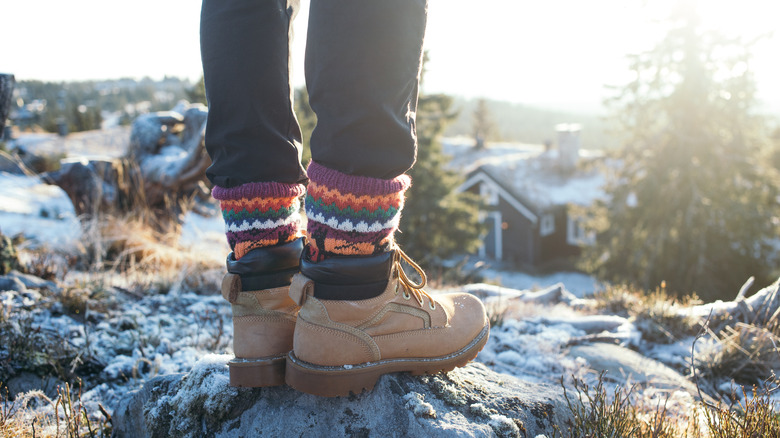Tuck in or treat clothing to prevent tick bites
Tucking the cuff of your pants into your socks and your shirt into your pants may not win you any fashion awards, but it can definitely reduce the risk of tick bites. Ticks can easily crawl up exposed skin, but tucking in your clothing creates a barrier they must climb over. Additionally, wearing clothing treated with permethrin spray can provide an extra layer of protection against ticks and other biting insects.
Permethrin is a synthetic insecticide safe for humans but toxic to ticks and other insects. It binds tightly to fabric fibers and can remain effective for several washes, making it a great choice for long camping trips. Permethrin is highly effective in repelling and even killing insects on contact, providing an additional defense against bug bites. Permethrin-treated clothing can provide protection for several washes and is safe to use around children and most pets. But it can be highly toxic to cats and fish, so opt for another prevention method if you plan on bringing your cat along. Avoid spray-treating any clothes or gear around these animals.
Treating your clothing isn’t your only option. Consider bringing a permethrin-treated mosquito net to cover your sleeping area. A net can protect against mosquitos and other flying insects while you sleep. Other fabrics like tent walls and sleeping bags can also be treated with permethrin to create a bug-free space for you to rest.
Choose the right fabrics to avoid mosquito bites

Since camping near bodies of water or in humid environments can increase your chances of encountering mosquitos, choosing your camping spot wisely can only do so much. In certain areas and seasons, mosquitoes just can’t be avoided, so the appropriate clothing is your next best defense. When it comes to camping attire, choose light-colored, tightly woven fabrics like cotton, polyester, denim, or thick wool.
Though denim and wool could pose a heat problem in the summer, these materials act as a barrier, making it harder for bugs to reach your skin. Avoid tight clothing like spandex yoga pants or shirts that can cling to your skin and make it easier for bugs to bite you. Opt for looser-fitting clothes to provide a better barrier against bugs, but avoid overly loose, billowy clothing.
Along with dressing appropriately, use bug repellent containing picaridin, DEET, or oil of lemon eucalyptus for the most effective insect protection. Cover up with long sleeves and pants, even in warm weather, to minimize exposed skin and prevent bugs from reaching your body. Hats and other accessories can also offer bug protection. A wide-brimmed hat shields your face and neck, while a mosquito net hat keeps insects away. Sunglasses, bandanas, scarves, and gloves also help fend off bug bites.
Wear light-colored clothing to avoid bees and wasps

Halbergman/Getty Images
Dark colors are often associated with predators in the insect world, making you a more attractive target. Choose lighter shades for your camping wardrobe to reduce unwanted attention from bugs, especially bees and wasps. Bees and wasps are known to be attracted to bright colors, as they can identify the colors of flowers.
Instead, choose muted, pale clothing to help minimize the risk of getting stung by these insects. Darker clothing absorbs heat, making you hotter and more uncomfortable in warm weather. The heat and sweat in these instances will inevitably attract some bee species and insects, so opting for lighter colors can help keep you cool and less appealing to bugs.
Also, avoid wearing scented products like perfumes, lotions, and hair products outdoors. These fragrances can attract bees and wasps and make you a more appealing target for bites. Opt for unscented options or skip them altogether when camping in bug-prone areas. As a bonus, lighter-colored clothing will also make it easier to spot ticks and insects that may have hitched a ride on your clothing. This can help you avoid potential bites or remove the pests before they become problematic.

